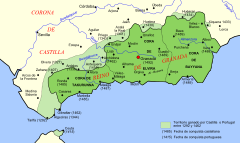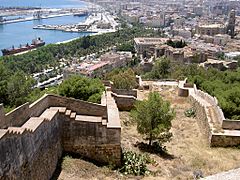Siege of Málaga (1487) facts for kids
Quick facts for kids Siege of Málaga (1487) |
|||||||
|---|---|---|---|---|---|---|---|
| Part of the Granada War | |||||||
 Alcazaba of Málaga, built by the Hammudid dynasty in the 11th century |
|||||||
|
|||||||
| Belligerents | |||||||
| Commanders and leaders | |||||||
The Siege of Málaga (1487) was an important event during the Reconquista, a long period when Christian kingdoms took back land from Muslim rule in Spain. During this siege, the Catholic Monarchs of Spain, Queen Isabella and King Ferdinand, captured the city of Málaga. It was a major port city controlled by the Emirate of Granada. The siege lasted for about four months. This conflict was also the first time that special vehicles, called ambulances, were used to carry injured people. Losing Málaga was a huge blow for Granada, as it was their second-largest city and most important port.
Contents
Why Málaga Was Attacked

Málaga was a key target for the Catholic Monarchs in their 1487 campaign. The Emirate of Granada had been steadily losing land to the Christian forces. King Ferdinand II of Aragon gathered a large army to attack. He left Córdoba with many soldiers and support troops. This army joined up with powerful cannons led by Francisco Ramírez de Madrid.
The Plan to Capture Málaga
The army decided to first attack a town called Vélez-Málaga. After that, they would continue west to Málaga itself. Spies from the Nasrid dynasty (the rulers of Granada) learned about the Christian army's movements. Because of this, many people in Vélez fled to the mountains.
The Spanish army reached Vélez-Málaga on April 17, 1487. It was a slow journey through difficult land. A few days later, lighter siege weapons arrived. The heavier ones could not be moved on the poor roads. Muhammad XIII of Granada (also known as El Zagal) tried to help Vélez. However, he was forced to retreat by the stronger Christian forces. When he returned to Granada, he found that his nephew, Abdallah Muhammad XII, had taken his place as ruler.
Seeing no hope of help, Vélez surrendered on April 27, 1487. The people were allowed to keep their lives, property, and religion. Smaller towns along the road to Málaga also surrendered. Málaga was the next big goal.
The City of Málaga
The Muslim city of Málaga was very important. It was the second-largest city in the emirate after Granada. It was also a major trading port on the Mediterranean Sea. The city was wealthy and had beautiful buildings, gardens, and fountains.
Málaga's Defenses
Málaga was surrounded by strong walls that were in good condition. Above the city was the Alcazaba of Málaga, a citadel or fortress. It was connected by a covered path to the very strong Gibralfaro fortress. A part of the city outside the main walls was also protected by a strong wall. Near the sea were many farms growing olives, oranges, pomegranates, and grapes. These grapes were used to make sweet Malaga wine, which was an important product for trade.
The city had plenty of cannons and ammunition. Besides its regular soldiers, there were volunteers from other towns. There were also experienced African soldiers called Gomeres. Hamet el Zegrí, a skilled commander who had defended Ronda before, was in charge of Málaga's defense.
The Siege Begins

While still at Vélez, King Ferdinand tried to get Málaga to surrender peacefully. However, Hamet el Zegrí refused his offers. Ferdinand left Vélez on May 7, 1487. He moved his army along the coast towards Málaga. The road passed between two hills defended by the Muslims. A battle took place until evening. The Christians managed to get around the Muslim position, and the Nasrid forces retreated to the Gibralfaro fortress.
The Christians then turned the landward hill into their own strong point. They began building defenses to surround the city. This involved digging trenches and building fences, or making earth walls where the ground was too rocky. A fleet of armed ships, including galleys and caravels, blocked the harbor. This cut off all access to the city from the sea.
Early Attacks and Royal Support
The first attack was on the part of the city outside the main walls. The Christians broke through the wall. After strong resistance, the Muslim defenders were pushed back into the main city. King Ferdinand II sent an expedition to the ruins of Algeciras. They went to get stone cannonballs that had been used in an earlier siege there. These would be used against Málaga.
Queen Isabella joined her husband at the siege. She brought her court, important church leaders, and nobles. Her presence helped to boost the morale of the Christian army.
Muslim Resistance and Outside Help
The Muslims inside Málaga kept firing cannons at the Christian lines. They also made repeated attacks outside the city walls. There were also attempts to send help to the city. In one case, El Zagal sent cavalry from Guadix. However, a stronger force sent by Abdallah stopped and defeated them. Abdallah then sent expensive gifts to the Catholic Monarchs. He assured them that he was friendly. In return, the monarchs agreed to leave his people in peace and allow trade between Granada and Spain.
Málaga began to run low on food supplies. The Holy Roman Empire also helped the Christian side. Maximilian I sent two ships from Flanders with military supplies.
King Ferdinand had planned to starve the city into surrender. However, he became impatient with the delays. He started building tall, mobile towers that could reach over the walls. He also began digging tunnels (mines) to enter the city from below or to weaken the walls. The Muslims fought back. They attacked and destroyed the towers. They also dug their own counter-tunnels to stop the Christian miners. Muslim ships also attacked the Christian fleet in the harbor.
The City's Desperate Situation
After three months, the Christians finally captured an outer tower. This tower was connected to the city wall by a bridge. This was a key point to get into the city. By this time, the people inside Málaga had run out of food. They were so hungry that they were eating dogs, cats, leaves from plants, and even chewing on animal hides.
Seeing their extreme suffering, Hamet el Zegrí finally agreed to a plan. He would withdraw with his soldiers to the Gibralfaro fortress. This would allow the people of the city to make terms with the Christians.
Surrender and Aftermath
After some failed attempts to negotiate terms, the city's representatives finally surrendered without conditions. They placed themselves at King Ferdinand's mercy. The city surrendered on August 13, 1487.
The citadel, the Alcazaba of Málaga, held out a little longer. It surrendered on August 18, 1487. Its leader, a merchant named Ali Dordux, surrendered on the condition that his group of twenty-five families could stay as Mudéjars (Muslims living under Christian rule). The Catholic Monarchs entered Málaga in triumph on August 18, 1487. The Gibralfaro fortress, still under Hamet el Zegrí's command, surrendered the next day.
Consequences for Málaga
The capture of Málaga was a very hard blow for the Muslim kingdom of Granada. They lost their most important seaport. King Ferdinand II had tried to negotiate a surrender several times during the siege. However, the defenders had refused. Because of this, the conquerors gave a harsh punishment to the defeated side.
Most of the people who survived were taken as prisoners or forced into slavery. Their property was taken away. Some were sent to North Africa in exchange for Christian prisoners. Others were sold to help pay for the costs of the war. Some were given as gifts. Hamet el Zegrí, the commander of the defense, faced severe consequences for his resistance.
The job of reorganizing the area was given to two experienced leaders. They used the help of Ali Dordux, the merchant who had surrendered the citadel. Land was given to the soldiers who had fought in the siege. Between 5,000 and 6,000 new settlers came to Málaga. They came from different parts of Spain, like Extremadura and Castile. About a thousand of them settled in the city itself.
Images for kids
See also
 In Spanish: Toma de Málaga (1487) para niños
In Spanish: Toma de Málaga (1487) para niños






